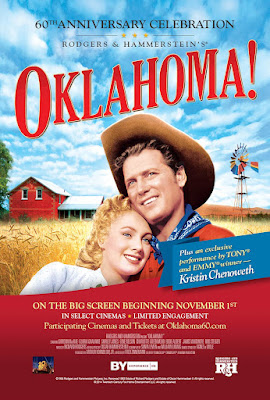Today we hardly see what the fuss was about. It’s easy to dismiss as corny a plot that hinges on which swain will buy a pretty girl’s picnic hamper at their town’s box social. And even some of the genuine innovations now seem old-fashioned. For instance, there’s that dream ballet in which a stand-in for the show’s leading lady dances out her romantic uncertainties through Agnes de Mille’s artsy choreography.
The dramatic ambitions of Hammerstein’s book hinge on the show’s strangest element, the handling of a character named Jud Fry. He’s a hired hand with a yen for Laurey, who’s clearly much more interested in a rakish cowboy named Curly. Scruffy and taciturn, with a taste for pornography, Jud is no one’s dream date. He’s treated with contempt by Curly (who encourages him to kill himself), and sneered at by everyone else. The new production that picked up Tony Awards in 2019 leans into the mystery of Jud, and why Laurey allows him to drive her to that box social. The whole section of the show involving Jud becomes intense and steamy, complete with a psychosexual dream ballet that is hardly as genteel as Agnes de Mille’s. And the interracial cast in the touring production features a very large transexual woman grotesquely playing a flirtatious role usually inhabited by someone petite and cute. At the performance I saw, this production was far too “woke” for most of the audience to tolerate.
Which brings me to the Hollywood version from 1955. After seeing Woke-lahoma! on the Ahmanson stage, I was glad to turn to a more traditional version, with the appealing Gordon MacRae as Curly, the lovely Shirley Jones making her film debut as Laurey, and other Hollywood musical stalwarts in the cast. The de Mille ballet remains excessive, featuring the dream-Laurey psychologically shaken by seeing a leering Jud in the company of some racy painted ladies. And some new histrionics are added, like Laurie pushing Jud out of his wagon when he tries to kiss her, and then Jud viciously setting fire to a haystack in an act of revenge. In this film, Jud is played by Rod Steiger. I hear Marlon Brando was considered for the role, and his brooding handsomeness might have helped explain the attraction/repulsion Laurey is supposed to be feeling. But who’d be tempted to go astray with as stolid a guy as Steiger? This casting just confirms the show’s basic contradictions. Rodgers and Hammerstein would try again to balance romantic fun with sexual tension in their next show, the brilliant Carousel.


Thoroughly enjoyed your post. Thank you!
ReplyDeleteI don't know who you are, Anonymous (though your name DOES get around), but I love you!
Delete